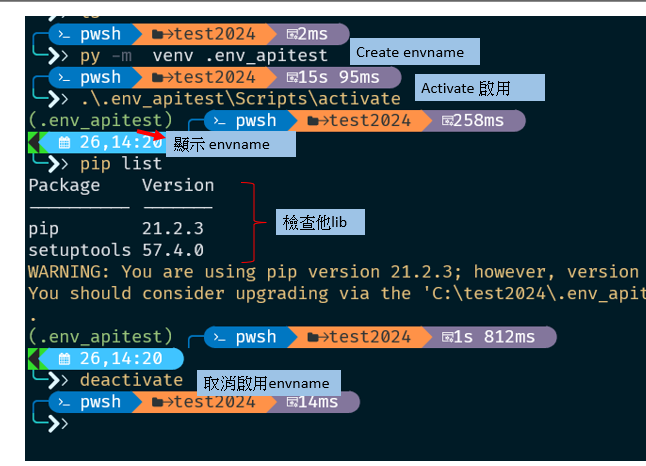Python to exe
今天想分享如何用 python 轉 exe,也就是說如果你把你的 python 檔案轉成 exe 放在其他電腦就可以執行。這個好處就是你不用在其他電腦安裝 python 或其他 library,就可以用。
Install Pyinstaller
這有很多方法和套件可以用,但我都用 pyinstaller
安裝 pyinstaller:
pip install pyinstaller
pyinstaller 用法
- 基本用法
1 | #simple convert |
- Adding Icons:
可以在下面連結下載 ico 也可以用,下載會是 .png檔案,需要轉成 .ico
1 | pyinstaller --onefile --icon=myicon.ico your_script.py |
update_python_jupyter
This is a note for change your python version in jupyter Notebook. 今天想要分享如何換在 jupyter Notebook 換不同 python 般本
Please Install latest python for example python 3.13 which is the latest version, if you are going to switch to python 3.13. You don’t have to install latest version, it’s because I want to switch to python3.13, please be noted.
請務必先安裝最新的 python 3.13,由於我要切換到 python 3.13,因此必須要先安裝 python 3.13。
Changing python version in jupyter
Step changing python version
Step1: Install package
Install Jupyter (optional):
pip install jupyterInstall ipkernel:
pip install ipykernel
You can also install under virtual environment
1 | #1. create virtual env with conda |
you can also use conda command conda env list to list virtual env.
Rename_and_List_file_example 列出檔案目錄和如重新立名
今天我想分享關於目錄和檔案相關範例,如重新立名,出檔案,我會用很多方式呈現出來。
List current directory 目錄利出檔案
list your file in current directory 目錄列出檔案
我們常在 linux 和 window 都會用 ‵ls‵ 或 ‵dir‵ 來列出我們目錄底下所有檔案。 可以用 os.listdir() 就可以利出所有目錄和檔案
目前目錄下:
os.listdir()指定位置:
os.listdir(path)
1 | import os |
output:
1 | counter.py |
filter specific file or file type 篩選檔名
有幾個方式可以用,如果要指定檔案類型 我們可以用: startswith() 或 endswith().
count_string_occurrences 文字出現的次數
This exercise is to show you how to count your string occurrences, or how many duplicated value. 我想分享如何找估重複文字次數。
iterate through list, and store in dictionary
[方法一] 基本 loop 把它存在 dictionary
output:
{'James': 1, 'Kelly': 2, 'Sammie': 1
1 | listofName=['James','Kelly', 'Sammie', 'Kelly'] |
其實可以寫成更簡短方式,其實跟上面方式一樣
1 | listofName=['James','Kelly', 'Sammie', 'Kelly'] |
如果沒出現就離開,出現就會+1,也可以這樣做 1+dictcollect.get(name,0)。
dictcollect.get(name, 0) checks if the name already exists as a key in the dictionary.
If it exists, the current count is retrieved.
If it doesn’t exist, 0 is returned.
[方法二] collection 裡面的 count
Function Annotations
Understanding Function Annotations -> ,:
Today I would like to share when we see an arrow or colon on function, basically there’s a term Function Annotation. I see some turtorial and see many developer beeen using it, and went and research on it.
You can think it’s just a comment, nothing else. It to tell people about your code expectation, like data type or return value. So let me show you some examples, and you will see the arrow or colon doesn’t mean anything, it just to tell people what this variable mean.
1 | def velocity(s: 'in miles', t: 'in hours') ->'mph': |
output:
{'s': 'in miles', 't': 'in hours', 'return': 'mph'}
from above example it just to tell user s is in mile, t is in hours, and return mph
You will see many people use like this to define datatype:
1 | def calculate(a: int, b: int)-> int: |
overall it just to tell people what the code expectation is or are.
Virtual Environment
今天來分享如何應用 virtual env 來提高工作環境等效率。如果使用 python library 我想信很多時候都會用 pip 來安裝他的 library 等 module。如果某些套件版本跟你專安不 match 造成無法 code 無法運行怎麼呢?這時你只有降版本,也就是可能要先移除再安特殊版本。另一種方式就是建立一個 virtual env 也就是類似虛擬環境,這裡可以安裝任何 package or library 跟主環境分離不會有相關。
我覺得這個很好用,如果你原本主環境安裝太多 library 你有時還要 debug,你可以一開就建立在乾淨環境,再安裝你要安裝個 library or module 等 package。
可以用這兩終方式建立 virtualenv,如:
virtualenv: 需要安裝套件venv:內建就有無須安裝特建
venv
Syntax:
python -m venv <my_env_name>
EX:python -m venv venv
- 如何用
1 | #create new directory |

virtualenv
Terminal-oh-my-posh
今天想要來分享如何在 window 上面設定像 Linux 或 Mac 相關花麗等冬端機 terminal,和以些 linux 不錯的指令。如果你們有用過 Linux,在用 window 很不習慣,尤其是指令。今天想分享如何用 Oh-my-posh 在 window 上面可以跟 Linux 的 Oh-my-zsh 有依樣效果。Window 是用在 powershell 上,他有支援很多 shell bash zsh powershell fish等等。我有寫一篇比較完整,在Medium 因此今天會寫簡短方法。
安裝工具
軟體安裝服務比較
如果你有用過 Ubuntu 都會看到大家常用 apt-get install 這命令,這個就是我稱為的安裝服務工具。他可以很快速幫助你要安裝個套件。我今天要介紹 3 個,但我會以 winget 優先用,如果 winget 沒有套件再選其他兩個。winget 是微軟開發因此我才會優先用他。我會盡可能不去商店下載。
正常來說 winget 預設鏡安裝了,如果你是 win10 都會安裝,如果指令找不到就用下方的方法。如果 winget有,那把 scoop安裝,Chocolatey就看你要挨裝嗎,我目前沒用到。
1 | Set-ExecutionPolicy -ExecutionPolicy RemoteSigned -Scope CurrentUser |
1 | Set-ExecutionPolicy -ExecutionPolicy RemoteSigned -Scope CurrentUser |
RegularExpression-Python
今天有想在這裡分享 Regular Expression,這也是大家不想碰到的,可就是一個很復雜的就越耗用。
我也沒有很勵害,但之前開發自動化,用很多。因此想藉由這編文章來寫下我所寫道的筆記和參考很多教學。
在介紹之前我們在 python 都會用到 re 或是 rex ,但在這我只會分享用 re,也就是要 import re,不然不能用。
常用的 req module
| Module | 說明 |
|---|---|
| match | Determine if the RE matches at the beginning of the string. |
| search | Scan through a string, looking for any location where this RE matches |
| findall | Find all substrings where the RE matches, and returns them as a list. |
| finditer | Find all substrings where the RE matches, and returns them as an iterator. |
compile()
1 | import re |
output:
None
cheenchih> >['chenchih', 'ChenChih']
match()
This function matches a regular expression pattern at the beginning of a string. If the pattern is found, it returns a match object, otherwise, it returns None.
1 | import re |
MY-SQL(Basic)
我想分享一些基本的DB(MYSQL)語法。之前面試有考不管是在Amazon,或Microsoft 都有考過我DB。我那時有準備筆記,但後來就不知跑哪。今天想在這篇寫關於SQL基本指令,有機會再寫高階的語法。
我住前是用MYSQL的DB軟體,你們可以選用其他的如MogoDB, Microsoft SQL server,orlacle DB等等。基本上語法都差不多,我猜的
- Table: employee:
1
2
3
4
5
6
7
8
9
10+----+-------+--------+--------------+
| id | Name | Salary | DepartmentID |
+----+-------+--------+--------------+
| 1 | Joe | 85000 | 1 |
| 2 | Henry | 80000 | 2 |
| 3 | Sam | 60000 | 1 |
| 4 | Max | 90000 | 1 |
| 5 | Janet | 69000 | 1 |
| 6 | Randy | 85000 | 1 |
+----+-------+--------+--------------+
SELECT & FROM
select * from
select 可以選擇要印那一欄,如果加*可以把所有內如印出來,以下是指令:
select * from employee;
1 | Table: employee; |
select Name 指定欄位
SELECT Name, Salary From Employee;